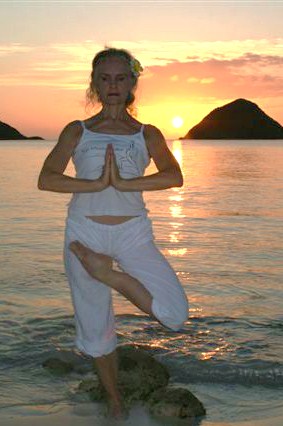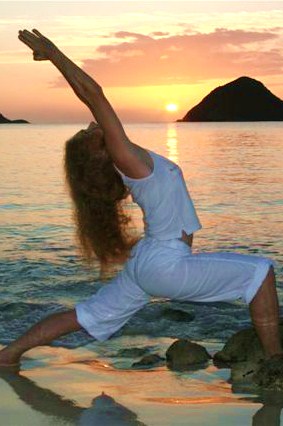 Because of the yoga variations swirling around today, I hope the following
list will enlighten the student to a deeper understanding of this
interesting and sometimes confusing topic.
Because of the yoga variations swirling around today, I hope the following
list will enlighten the student to a deeper understanding of this
interesting and sometimes confusing topic.
- L. DiGrazia, Director, Yoga School Kailua, 2001
The Yoga systems - Direct experience is the goal of yoga;
awareness of what is real, free of the constraints and fluctuations of
consciousness. Mastering of the forces of the universe, surrendering
gross vibrations of the external world to refine the vibrations of the
internal and then to become one with the subtle vibrations. This is a
sample of the "kinds of yoga," but not a complete list. Like the sects of
Protestantism and other Christian sects, for example, they are almost too
numerous to list, and like other human-made systems will continue to expand
in number. The types of yoga below, are the most notable, historical, or
the ones we hear most about today.
Abhava yoga - Yoga of nonbeing.
Adhyatma yoga - First spoken of yoga as spiritual method in the
Katha-Upanishad (6th century BCE or earlier) - yoga of inmost self,
whereby the sage may come to know the great force hidden in the cave of the
heart.
Asht-anga yoga - Yoga of the eight limbs of Patanjali's system of
the Yoga Sutras. It consists of the eight practices of the eight limbs
from Book II, sutra 29. Today, this yoga is used to describe the
vigorous, vinyasa style of Jois, an Indian yogi. I believe Madonna made
this one popular in the West by being a practitioner.
Bhakti or bhakta yoga - Approach of the heart. Ideal of devotion
(bhakti) to the divine as a superperson (purusha-uttama). The Gita
(Bhagavad Gita) introduced this concept - 4th, 5th century. Devotion to
an ideal. Union by love. Aspirant devotes oneself to a special deity or
guru. Narada Sutra says love (Bhakti) is easier than other methods. It's
being is the nature of peace and supreme bliss. Divided into 2 divisions.
!.) preparatory, and 2.) Devotional. One prepares oneself for the holy
guardian angel. Christ was a Bhakti Yogi.
Bikram yoga - Yoga named by Mr. C. Bikram. Yoga room is over 100
degrees. Only 26 yoga postures are practiced over and over in this
"style." Mr. Bikram lives and serves in Hollywood. Currently very popular
fad yoga.
Classic yoga - Yoga of India and that of Patanjali's yoga sutras.

Gnana yoga - Union through Knowledge. Gnana yoga is that yoga
which commences with a study of the impermanent wisdom of this world and
ends with the knowledge of the permanently wisdom of the Atman (self); 1.
distinguishing the real from the unreal - viveka; 2. indifference to the
joys and sufferings of the world - vairagya. 3. Release, and the unity
with Atman -mukti. Wisdom is a key word. Everything culminates in
wisdom, fire of wisdom, nothing so pure as wisdom.
Hatha Yoga - Forceful yoga; linked to the name Goraksha - 10th
century master. Control of the physical body in order to open it to the
cosmic energy by breathing and physical exercises. Helps to manipulate the
life force (prana), breath control, mental concentration. The eight limbs
of yoga apply to hatha and raja yogas. Hatha yoga has come under attack
and rejected because "it merely leads to pain." It is also said that one
can lead an animal into the stall by enticing it with fresh grass or by
whipping it, which causes the animal to panic. The first way is better,
thus gentle yoga practice is the best and most effective way to practice
this physical discipline. Hatha yoga is seen as the stairway to raja. Ha
and tha stand for sun and moon or balance; sun is the front and moon is the
back. Hatha yoga's objective is to transform the human body to make it a
worthy vehicle for self-realization. The yogin becomes free from
limitations such as disease, removes dullness, defects and impurities. The
body becomes youthful. When the body is healthy and free, one can sit
still and explore the mysteries of the unknown without conflict or
distortion. See eight limbs.
Integral yoga - (purna yoga) Sri Aurobindo described his spiritual
approach as integral yoga. Combines quest for individual liberation with
the evolutionary destiny of humanity. This yoga style purported to offer a
viable spiritual integral path for the present global crisis. He
understood this as a transition from the mental to the supramental (or
divinely inspired) consciousness.
Iyengar yoga - yoga named by Mr. Iyengar. Author of "Light on
Yoga." Often described as very intense, also referred to as rigid form.
Predominately hatha yoga style. Mr. Iyengar lives in India.
Jnana yoga - Withdrawal of consciousness from the outer world of
the senses by working from the center to the periphery to effect union of
higher to lower by control of thought.
Karma yoga - conscious execution of actions. Control of one's
actions from non-selfish motives. Union/yoga of good deeds. Union through
work, related to gnana yoga. Key to karma yoga is control, or restraint.
Image: being calm in stressful surroundings.
Kriya yoga - Yoga of ritual action. Its goal is to awaken the
kundalini through mental focusing (dharana) and breath control on the basis
of bhakti yoga.
Kundalini yoga, agni yoga, or laya yoga - Seeks to control the vast
psycho spiritual energy of the body. Concentrating on the psychic centers
to awaken the primordial cosmic energy of the individual. Also: fire yoga.
Mantra yoga - Meditative recitation of sacred sounds. Making use
of the repetition of certain words and phrases to steady the mind. Union
through speech. Repetition until the word spoken become one in a perfect
concentration. All prayers can be turned into mantras. Repetitions of
names of gods for example when the speaker, the Great opens the Eye. The
first chakkra --- four petalled Muladhara - lotus is the seed of speech,
brilliant as lightening.. Mantras are given by guru. After so many reps,
once can rise above the ground; and more, be absorbed by the absolute.
Power yoga - intense vinyasa style, hatha yoga. Very athletic,
rapid. Prepares body-mind for ashtanga.
Raja yoga - Classic yoga recognized by Brahmins as on of the six
orthodox systems and is said to embrace all six yogas: karma, bhakti,
jnana, mantra, laya or kundalini and hatha. Referred to also as the yoga
of good will. Defined as the earliest and most scientific treatment of
the subject of self-transformation, for the attainment of union with the
Real, the Eternal. it develops will through concentration and meditation
by tuning the nervous system to be in harmony with higher vibrations. Raja
yoga has eight steps: yama, self restraint; niyama, self-discipline; asana,
posture; pranayama (control of the breath; pratyahara, control of the
senses; dharana, concentration; dhyana, meditation; samadhi, contemplation.
The three fold process, samyama, includes dharana, dhyana and samadhi:
awareness, meditation and ecstasy are included in raja yoga. In the yoga
sutras, hatha yoga, asana and breathing is seen as preparation discipline
for the samyamas. The split in the ashtanga happened in the 11th century
when an attempt was made to distinguish the meditative and the physical
aspects. There is no distinction.
 Because of the yoga variations swirling around today, I hope the following
list will enlighten the student to a deeper understanding of this
interesting and sometimes confusing topic.
Because of the yoga variations swirling around today, I hope the following
list will enlighten the student to a deeper understanding of this
interesting and sometimes confusing topic.